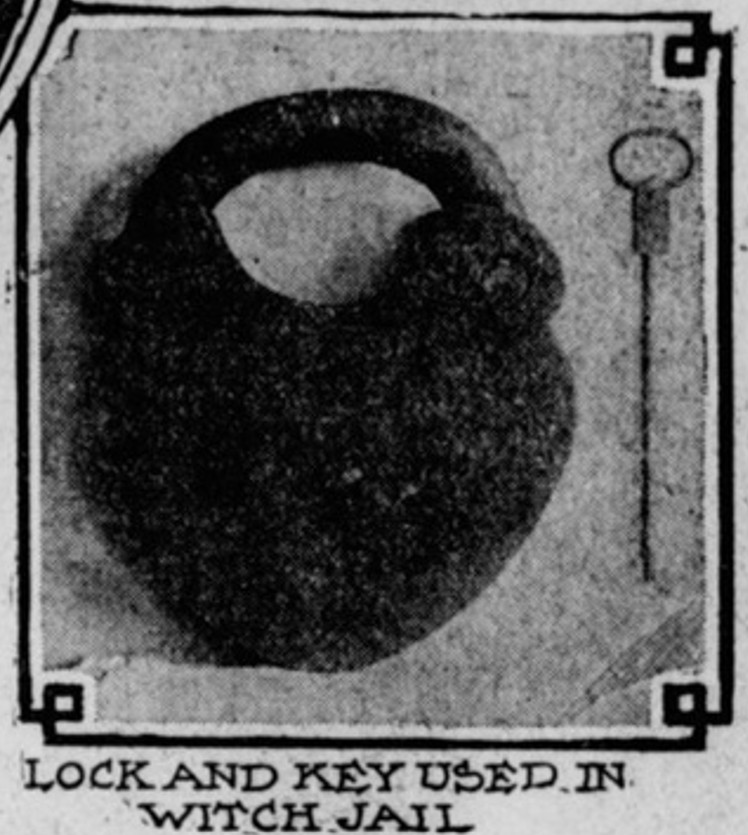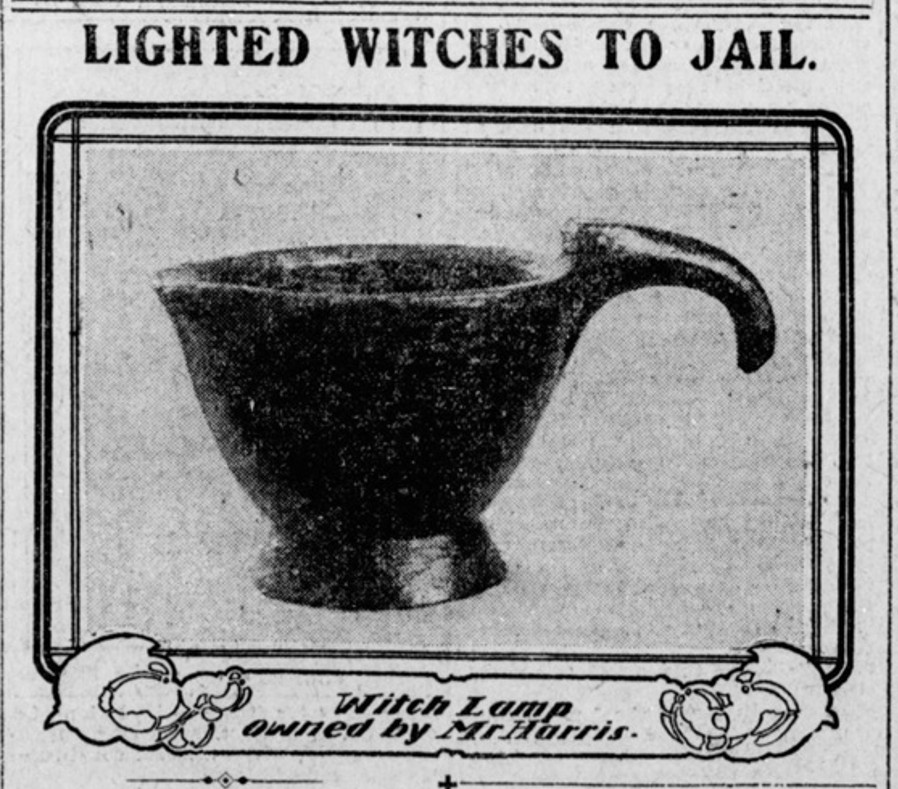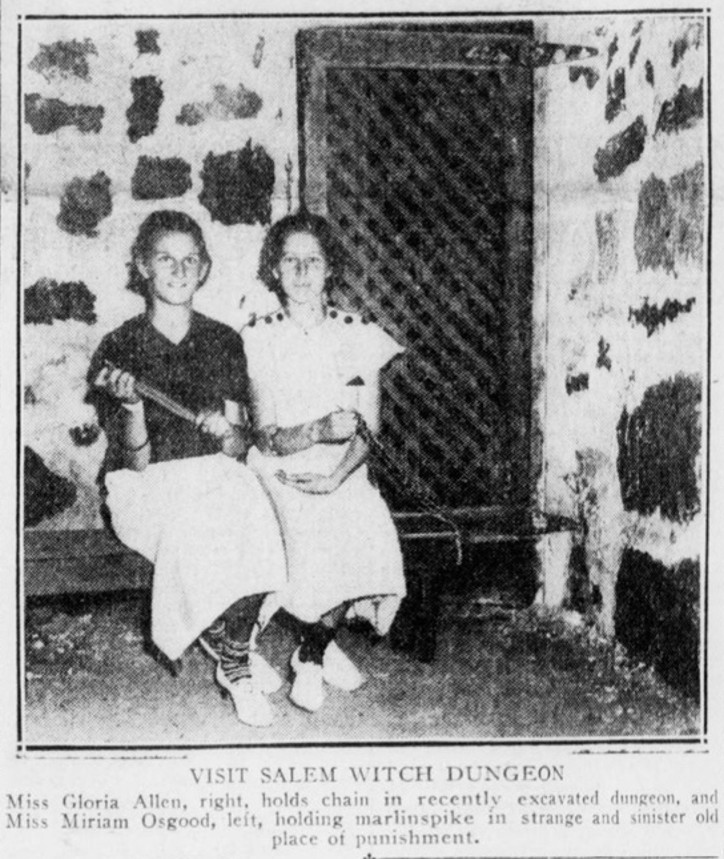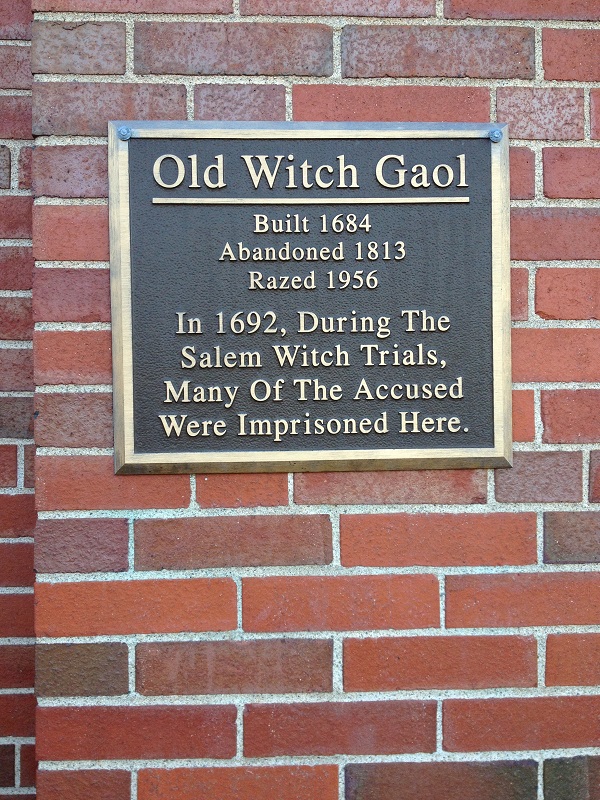The Salem Witch Jail, also known as the Essex County Jail, was a county jail where some of the accused witches were kept during the Salem Witch Trials in 1692.
The building was located on what is now the corner of St. Peter Street and Federal Street in Salem, Mass.
On March 8, 1683, the Town of Salem voted to build a new county jail in Salem and awarded 30 pounds for the new project.
The jail was built in 1684 and was a small wooden building measuring about 20 square feet in size with two stone-walled dungeons in the basement where the more dangerous prisoners were kept.
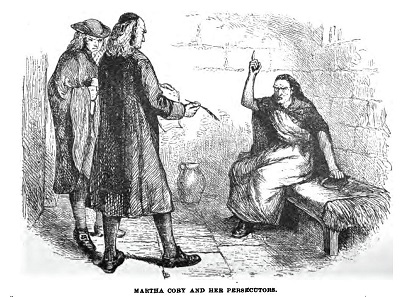
Federal Street didn’t exist at the time, so the front door of the prison was located on Prison Lane, which is now known as St. Peter Street.
The jailkeeper of the Salem jail in 1692 was William Dounton. The locals would often gather in the kitchen of the jail to socialize, and Dounton would sell them grog and beer.
The most dangerous prisoners, including the accused witches as well as pirates and people scheduled for execution, were kept in the dungeon downstairs, while other prisoners served out their sentences upstairs in oak-framed rooms.
Since the Salem jail was too small to hold all of the accused witches during the trials, only a handful of them were held there, and the others were held in the jails in Ipswich, Boston, and Cambridge.
Some of the accused witches who were held in the Salem jail were:
- Sarah Good, arrested on March 1, 1692, six weeks later transferred to the Boston jail and then sent to the Ipswich jail
- Sarah Osborne, arrested on March 1, 1692, later transferred to Boston jail on March 7 where she died on May 10, 1692
- Martha Corey, arrested on March 21, 1692
- Rebecca Nurse, arrested on March 24, 1692, later transferred to the Boston jail on April 12, 1692
- Dorcas (Dorothy) Good, arrested on March 24, 1692 and jailed in Salem, one month later transferred to the Boston jail and then sent to the Ipswich jail, released on bail December 10, 1692
- Giles Corey, arrested on April 18, 1692, later transferred to the Boston jail on May 13, 1692
- Mary Easty, arrested in April of 1692, later transferred to the Boston jail
- Abigail Hobbs, arrested on April 18, 1692
- Bridget Bishop, arrested on April 18, 1692, later transferred to the Boston jail on May 13, 1692
- Mary Warren, arrested on April 18, 1692
- Sarah Wildes, arrested in April of 1692, later transferred to the Boston jail on May 13, 1692
- Mary Witheridge, indicted in September of 1692
- Mary English, arrested on April 19, 1692, later transferred to Boston jail on May 13, 1692
- Edward Bishop, arrested on April 21, 1692, later transferred to the Boston jail on May 13, 1692
- Sarah Bishop, arrested on April 21, 1692, later transferred to the Boston jail on May 13, 1692
- William Hobbs, arrested on April 21, 1692, later transferred to the Boston jail on May 13, 1692
- Deliverance Hobbs, arrested on April 21, 1692
- Sarah Buckley, arrested in May of 1692
- George Jacobs Sr, arrested on May 10, 1692, later transferred to the Boston jail on May 13, 1692
- Mary Black (Lieutenant Nathaniel Putnam’s slave), later transferred to the Boston jail on May 13, 1692
- Margaret Jacobs, arrested on May 10, 1692, wrote a letter her father in August during which she describes being “confined here in a loathsome dungeon”
- Alice Parker, arrested on May 12, 1692, later transferred to Boston jail on May 13, 1692
- Sarah Pease, transferred to the Salem jail on May 25, 1692
- Ann Pudeator, arrested on May 12, 1692, later transferred to Boston jail on May 13, 1692
- Sarah Proctor, arrested in May of 1692 and held elsewhere, transferred to the Salem jail on May 25, 1692
- Elizabeth Howe, arrested on May 29, 1692
- Mary Toothaker, arrested in late May of 1692
- Henry Salter, arrested in September of 1692
- Elizabeth Scargen and her child, spent six months in jail, her child died in prison after four months
The county voted to rebuild and enlarge the jail in 1763 using as much of the original materials as possible. The jail was raised up on sills, making it a three-story building instead of a two-story, and the roof was rebuilt to cover the new additions on the north and west sections of the building (Goodell 1952.)
A hallway ran through the building, dividing the cells used for criminals and those for poor debtors. The jailer’s offices were located in the southeast section of the building, and the kitchen was located in the southwest section. The jailer’s apartments were located on the second floor.
In 1766, County Street was constructed next to the jail, which intersected with St. Peter Street and was later renamed Federal Street in 1792.
In 1813, the jail was abandoned after a new county jail was built further down on St. Peter Street.
In 1818, two men, Amos and Edward Smith, bought the old jail for $800 and converted it into a dwelling. The hallway that ran through the building was removed, the two dungeons were walled up, and winding stairs were installed between the first and second floor in the space formerly occupied by the large oven in the kitchen and the jailer’s room above. The house also featured a two-story library with a gallery around it, which was finished in heavy black walnut.
In 1857, a historian and member of the Massachusetts Historical Society and vice-president of the Essex Institute, Abner Cheney Goodell Jr., rented the old jail building and later bought it in 1863. Goodell gave numerous interviews with the press about the building and its history.
Goodell Jr.’s son, Alfred Putnam Goodell, was born in the home on February 18, 1877. Goodell Jr. later died in the home on July 20, 1914, after a long illness, and left the home to Alfred.
According to a news report in the Boston Record, Alfred Goodell first discovered the dungeon below the house in 1934 and excavated it. During excavation, Alfred and his wife found a pair of heavy chains that were probably once used to chain the accused prisoners to the walls.
Alfred’s wife also discovered a collection of old papers from the jail in an old sealed closet that dated back to the times of the Salem Witch Trials and included bills for the prisoner’s room and board, which the prisoners were required to pay themselves, as well as letters from some of the accused witches, including a letter from Margaret Jacobs to her father, George Jacobs, describing the “savagery” of her imprisonment.
In 1935, Alfred and his wife began offering tours of the home and the old dungeon underneath, calling it the Old Witch Jail and Dungeon, and hired John Beresford Hatch to manage the business.
In 1949, Marion L. Starkey, author of The Devil in Massachusetts, gave a talk titled “The Best People Were Witches” at the old jail for the North Shore Simmons Club and descendants of the accused, including Senator Saltonstall, Florence Nurse, and Charles S. Tapley.
The talk was held in the drawing room of the house, which used to be the kitchen of the jail. After the talk, Alfred Putnam Goodell led the group on a tour of the dungeon and the library, where several thousand books, documents, and pamphlets about witchcraft and the Salem Witch Trials were on exhibit.
The hostesses of the meeting, Esther Usher, Elizabeth Putnam, Margaret Rodden, and Mrs. William Russell, dressed in costumes on loan from the Witch House.
In 1956, the New England Telephone Company demolished the building and constructed their new headquarters, a large brick building, in its place. A plaque dedicated to the old jail can be found on the front of the building.
When construction workers were digging the foundation for the brick building, they uncovered the old dungeon underneath and donated several wooden beams from the dungeon to the Peabody Essex Museum. One of the beams is now on display at the Salem Witch Museum, and the other beam is on display at the Witch Dungeon Museum.
A small piece of oak timber from the jail was also used to make the handle on a replica gun carriage for a War of 1812-era cannon restored by local antique collector Albert Goodhue Jr.
“Thus we got one authentic bit of Old Salem into the replica of America’s gun carriage,” Goodhue was quoted as saying in a Boston Globe news report in 1956.
Sources:
“Witch Torture Dungeon Bared.” The Boston Record, 13 June. 1935, p. 3.
“Witch Dungeon Open to the Public.” The Boston Post, 16 June. 1935, p. 1.
“Witches are Mr. Goodell’s Specialty: Salem Man Who Lives in an Atmosphere of Haunted Past.” The Boston Herald, 13 May. 1906, p. 70.
“Jailer’s Bill of 1629 Found in Old House.” Greensburg Daily Tribune, 29 Oct. 1934, p. 18.
“Devil Author to Speak at Witches’ Prison, Salem.” The Boston Globe, 15 Sept. 1949, p. 2.
Goodell, Alfred Putnam. The Old Witch Jail and Dungeon. Goodell, 1952, archive.org/details/oldwitchjaildung00good/page/n5/mode/2up
“SWP No. 166: Death Warrants Folder and Census of Prisoners (May – July 1692.” Salem Witch Trials Documentary Archive and Transcription Project, salem.lib.virginia.edu/n166.html
“SWP: No. 171: Officials’ Expense Accounts for 1692 (Submitted 1692 – 1694).” Salem Witch Trials Documentary Archive and Transcription Project, salem.lib.virginia.edu/n171.html
“Obituary for Abner Cheney Goodell.” Newspapers.com, newspapers.com/clip/37032497/obituary-for-abner-cheney-goodell/
“1812 Raider’s Cannon Restored at Marblehead.” The Boston Globe, 5 June. 1956, p. 32.

